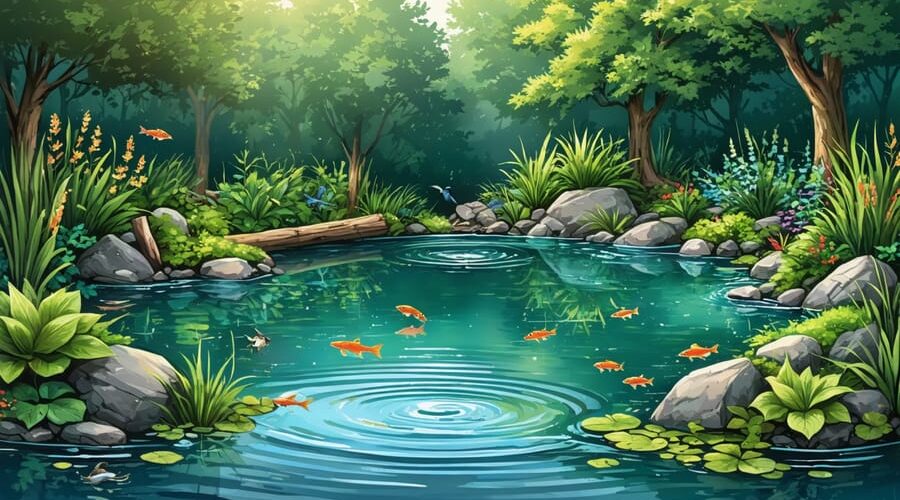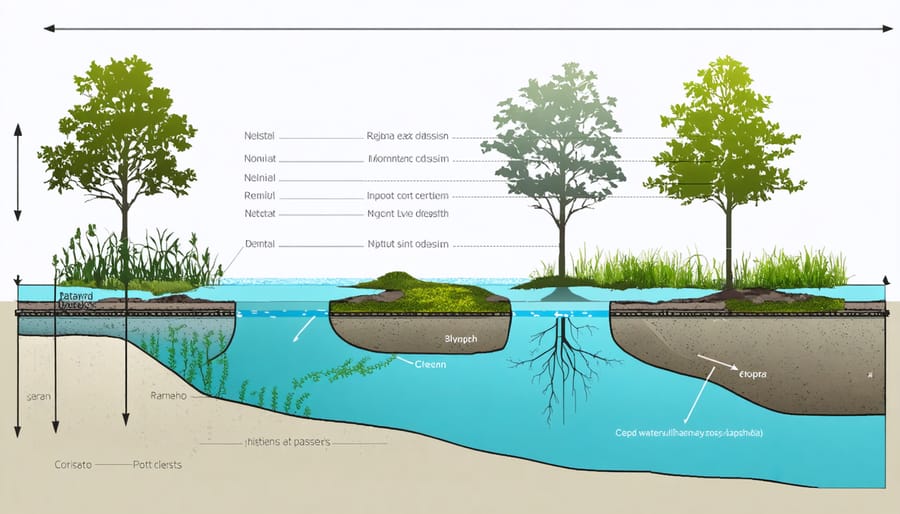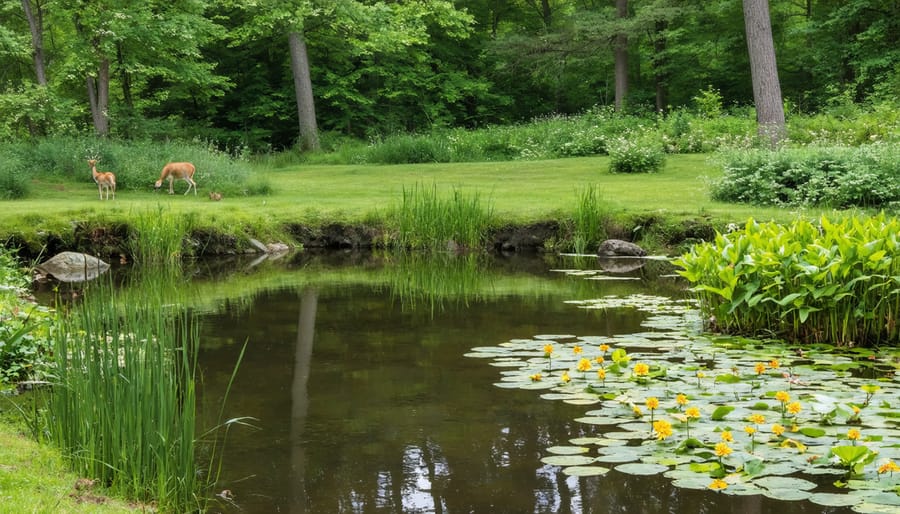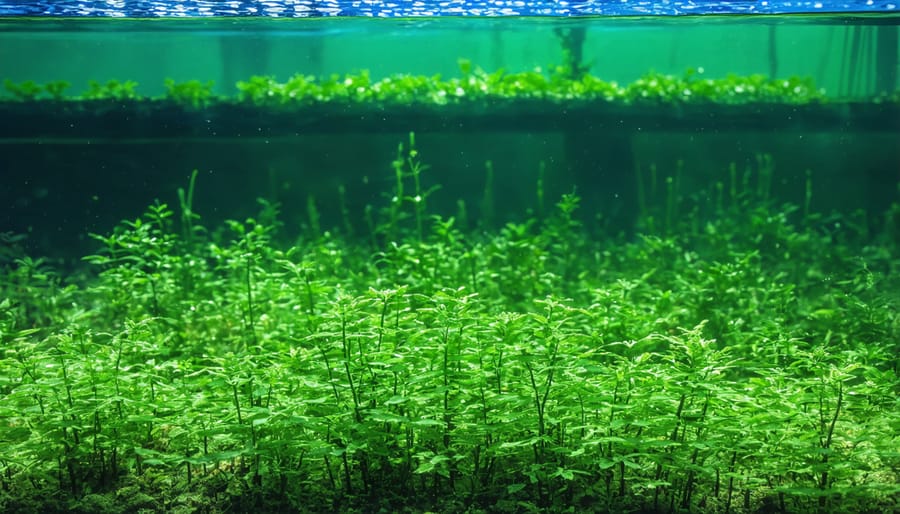
Natural Water Flow: The Secret to a Thriving Pond Ecosystem
Transform your pond into a thriving ecosystem by mastering the delicate balance between water flow and natural habitats. Whether you’re maintaining a backyard water garden or managing a larger pond, understanding ecohydrological principles helps create sustainable aquatic environments that support diverse life forms while maintaining healthy water cycles.
Start by learning to measure pond biodiversity and water flow patterns – these fundamental metrics reveal how well your pond supports life while maintaining natural circulation. Plant native species along the pond edges to create natural filtration zones that slow water movement and provide shelter for wildlife. Position rocks and logs strategically to create microhabitats that enhance water oxygenation while offering safe spaces for fish and amphibians.
This practical approach to ecohydrology doesn’t just create a prettier pond – it establishes a self-sustaining ecosystem where water quality, plant life, and animal habitats work together naturally. By understanding these connections, you’ll spend less time on maintenance and more time enjoying the vibrant life your pond supports.
Understanding Your Pond’s Natural Water Balance
Water Movement Patterns
Water movement in pond systems follows fascinating natural water flow patterns that mirror what we see in nature. Think of your pond as a mini ecosystem where water is constantly on the move. When rain falls, it creates ripples that help distribute oxygen throughout the water. This movement is essential for healthy pond life, much like stirring a cup of tea helps dissolve sugar evenly.
The water in your pond naturally cycles through different zones. Surface water moves horizontally, creating gentle currents that carry nutrients to plants and fish. Meanwhile, deeper water moves vertically as temperatures change throughout the day. Warmer water rises while cooler water sinks, creating a natural mixing effect that’s vital for pond health.
Wind also plays a crucial role, creating surface movement that helps oxygenate the water. These natural movements help prevent stagnation and maintain a balanced ecosystem. Understanding these patterns helps you work with nature rather than against it when managing your pond.

Seasonal Changes and Adaptations
As your pond transitions through the seasons, it undergoes fascinating changes that affect its water levels, chemistry, and ecosystem dynamics. During spring, increased rainfall and snowmelt boost water levels, creating optimal conditions for emerging plants and aquatic life. Summer brings higher temperatures, leading to increased evaporation and potentially lower water levels, while promoting vigorous plant growth and seasonal wildlife adaptations.
Fall introduces unique challenges as falling leaves can affect water quality, but this natural process also provides essential nutrients for the ecosystem. Winter brings reduced biological activity, with ice formation potentially limiting oxygen exchange. To maintain a healthy pond year-round, consider adjusting your maintenance routine seasonally: clearing debris in fall, managing water levels in summer, and ensuring proper aeration in winter.
Each season presents opportunities to work with nature rather than against it. Installing overflow systems for spring rains, providing shade during intense summer heat, and maintaining open water areas during winter can help your pond thrive through seasonal changes while supporting its natural cycles.
Creating Wildlife-Friendly Water Flow
Natural Filtration Zones
Natural filtration zones are nature’s way of keeping pond water clean and healthy, and they’re surprisingly easy to create in your own water garden. These areas work like living filters, using carefully selected plants and natural materials to remove excess nutrients and pollutants from the water.
Start by designating about 20-30% of your pond’s surface area for filtration. Create shallow shelves or terraces at different depths, ranging from 2 to 12 inches deep. This variety allows you to incorporate different types of filtering plants, each playing a unique role in water purification.
For the best results, layer your filtration zone from bottom to top. Begin with a base of clean gravel, which provides surface area for beneficial bacteria to colonize. Add aquatic soil on top for plant nutrition, then cap it with another thin layer of gravel to prevent soil from floating away.
Choose plants that are known for their filtering abilities. Rushes and sedges work wonderfully in shallow areas, while water iris and cattails thrive in slightly deeper zones. Don’t forget to include submerged plants like hornwort, which help oxygenate the water while absorbing excess nutrients.
Position your filtration zone where water naturally flows into the pond. This ensures that water passes through the plant roots before entering the main pond area. For added effectiveness, consider creating multiple smaller filtration zones rather than one large area.
Remember to maintain these zones by trimming plants regularly and removing dead plant material. This prevents decomposing matter from releasing nutrients back into the water and maintains the efficiency of your natural filtration system.
Wildlife Access Points
Creating safe access points for wildlife is essential for a thriving pond ecosystem. Animals need easy ways to enter and exit the water without getting trapped or injured. A gradual slope at one or more edges of your pond is the most natural approach, mimicking the shoreline of natural water bodies. Aim for a slope ratio of about 1:3 (one foot vertical for every three feet horizontal), which works well for most creatures.
Install partially submerged logs or large rocks that extend from the water onto the bank, creating natural ramps for amphibians and small mammals. These features also double as basking spots for turtles and provide refuge for smaller pond inhabitants. For steeper sections, consider building wildlife ladders – simple structures made from weather-resistant wood or stone that create steps leading in and out of the water.
Remember to include shallow areas around the pond’s edge where smaller animals can wade safely. These zones, typically 2-4 inches deep, are particularly important for birds, butterflies, and other insects that need to access water without swimming. Installing a beach-like area with gravel or small stones provides secure footing for wildlife while helping filter the water.
If you have deeper sections in your pond, floating platforms or islands can serve as rest stops for waterfowl and other aquatic visitors. Position these features near the pond’s edge to create connecting points between land and water. During installation, ensure there are no sharp edges or materials that could harm wildlife, and regularly check access points for stability and wear.

Plant Selection for Enhanced Water Quality
Marginal Plants
Marginal plants play a vital role in creating a healthy transition zone between your pond and the surrounding landscape. These plants thrive in shallow water or consistently wet soil around the pond’s edges, helping to stabilize banks and filter water naturally.
Popular marginal plants include Yellow Flag Iris, which adds vibrant color while providing excellent erosion control. Marsh Marigold offers cheerful spring blooms and spreads gradually to create dense coverage. For texture and height, consider Reed Sweet Grass or Cattails, though be mindful as they can spread aggressively in ideal conditions.
Japanese Rush and Sedges are perfect for smaller ponds, creating an attractive border without overwhelming the space. Water Forget-me-not adds delicate blue flowers and provides shelter for small pond creatures. Purple Loosestrife, while beautiful, should be chosen carefully as it can be invasive in some regions.
These plants offer more than just visual appeal – they provide crucial habitat for wildlife, help prevent algae growth by absorbing excess nutrients, and create natural filtration for your pond water. When planting, position them in mesh baskets with aquatic compost, submerged in 2-6 inches of water. For the best results, plant in spring or early summer, and space them according to their mature size to prevent overcrowding.
Submerged Oxygenators
Submerged oxygenating plants are the unsung heroes of a healthy pond ecosystem. These underwater plants work tirelessly beneath the surface, providing essential oxygen while absorbing excess nutrients that could otherwise fuel algae growth. Think of them as your pond’s natural filtering system!
Popular varieties like Hornwort, Elodea, and Water Milfoil are excellent choices for beginners. These hardy plants thrive in most conditions and require minimal maintenance. They create dense underwater forests that serve multiple purposes: providing shelter for fish fry, supporting beneficial microorganisms, and competing with algae for nutrients.
For best results, aim to cover about 50-60% of your pond’s bottom with these oxygen-producing powerhouses. Plant them in small bunches, weighted down with plant anchors or planted in mesh baskets with aquatic soil. Don’t worry if they seem sparse at first – these plants grow quickly during warm seasons.
Remember to thin them out occasionally, especially during summer months when growth is vigorous. This prevents overcrowding and maintains healthy water circulation. The trimmed portions make excellent natural fertilizer for your garden beds!
A well-balanced collection of submerged plants will help maintain crystal-clear water while creating a thriving ecosystem for fish and other aquatic life.

Maintaining Natural Balance
Seasonal Maintenance Schedule
Spring brings the most critical maintenance tasks as your pond awakens from winter. In March, remove debris and dead plant material that accumulated during winter. Test water quality and adjust pH levels if needed. April is perfect for dividing and replanting marginal plants and starting up filtration systems.
Summer maintenance focuses on managing plant growth and water quality. June through August, regularly trim aquatic plants to prevent overgrowth and maintain proper water flow. Monitor water levels weekly, topping up when necessary due to evaporation. Remove algae growth promptly and check pump function every two weeks.
Fall preparation begins in September with gradual plant cutbacks. October is crucial for installing protective netting before leaf fall and reducing feeding as temperatures drop. Remove fallen leaves daily to prevent excess organic matter decomposition.
Winter maintenance is minimal but important. November through February, maintain a small hole in ice coverage for gas exchange, but avoid breaking ice as this can stress wildlife. Check water levels monthly and remove any visible debris when possible.
Year-round tasks include monthly water testing, regular filter cleaning according to manufacturer guidelines, and monitoring wildlife activity. Keep records of maintenance activities and water quality readings to establish patterns and anticipate potential issues before they become problems.
Remember to adjust this schedule based on your local climate and specific pond conditions. What works in warmer regions may need modification for colder areas.
Problem-Solving Naturally
When facing pond challenges, nature often provides the best solutions. Instead of reaching for chemical fixes, consider working with your pond’s natural ecosystem. For example, excess algae growth can be managed by introducing more floating plants that compete for nutrients and provide shade. These plants not only help control algae but also create habitats for beneficial insects and amphibians.
Water quality issues often improve by establishing a proper balance of aquatic plants. Deep-rooted plants help stabilize sediment and filter water naturally, while surface plants provide shelter for fish and help regulate water temperature. If you notice murky water, consider adding submerged oxygenating plants rather than artificial filters.
Bank erosion can be addressed by planting native marginal species with strong root systems. These plants hold soil in place while creating beautiful, natural edges that welcome wildlife. For pest control, encourage natural predators like dragonflies and birds by providing appropriate habitats and perches.
When dealing with water level fluctuations, create deeper zones and shallow margins that mimic natural ponds. This diversity in depth helps maintain stable water levels and provides various microhabitats for different species. Remember, a healthy pond ecosystem is self-regulating – our role is to support these natural processes rather than fight against them.
By working with nature rather than against it, you’ll create a more resilient and beautiful water feature that requires less maintenance over time.
Creating a thriving pond ecosystem doesn’t have to be complicated. By following natural ecohydrological principles, you can maintain a beautiful and balanced water feature that practically takes care of itself. Remember that nature has perfected these systems over millions of years, and our best approach is often to work with these natural processes rather than against them.
We’ve explored how proper plant selection, strategic water flow management, and careful consideration of your local climate can create a self-sustaining environment. By incorporating native species and maintaining appropriate water depths, you’re not just creating a pretty garden feature – you’re establishing a living ecosystem that supports local wildlife and contributes to environmental health.
The key takeaway is to start small and observe how your pond responds to changes. Let natural processes guide your management decisions, and don’t rush to intervene at the first sign of change. A balanced ecosystem will develop its own rhythms and cycles.
Consider your pond as part of the larger environment, not just an isolated water feature. When you work with nature’s principles, you’ll spend less time on maintenance and more time enjoying the peaceful atmosphere of your water garden. Remember, the most successful ponds are those that mirror natural systems, creating harmony between water, plants, and wildlife.
Start implementing these natural approaches today, and watch as your pond transforms into a vibrant, self-sustaining ecosystem that brings joy and natural beauty to your outdoor space.
